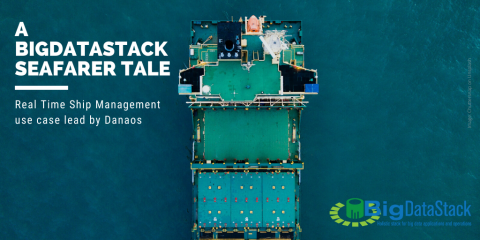
Real Time Ship Management Danaos use case
A Seafarer's vessel has to complete its route within a specific time-frame. When a part of the main engine fails unexpectedly, the ship risks staying off-hire. This can be very damaging to a shipping company, as chartering revenues decrease, while replacing a spare part immediately increases cost. The seafarer needs identification of potential failure to allow timely ordering, or even replacement of spare parts before failure.
The BigDataStack Seafarer tale tells the story of the Real Time Ship Management (RSM) use case led by Danaos Corporation, one of the largest independent owners of modern, large-size containerships. The use case exploits the BigDataStack environment with an emphasis on the data as a service offering for big data management, its analytics and methods for scheduling of orders, preventive maintenance, visualization of the current state and final results.
Real Time Ship Management Danaos use case focuses on Data As A Service
Danaos platform is an integrated web-based service that combines data from sensors onboard, operational data from a shipping company’s database and weather data in order to assist the technical and operations department of a shipping company to monitor its vessels. Its practical use is to provide an overview of a vessel’s performance and alert the users when policy-based rules are violated. By incorporating these aspects through the Danaos platform, BigDataStack allows shipping companies to utilize their data and use them in a difficult decision-making process, such as:
- Monitor the main engine of a vessel.
- Identify malfunction patterns and notify accordingly the supply department.
- Automatically order the appropriate spare part to be delivered at a port on route.
- Minimize the overall maintenance cost.
- Avoid off-hire seasons due to machinery failures and unexpected but compulsory maintenance.
Who are the actual seafarers of this tale?
The BigDataStack seafarer's are sailing the big-data-sea and this is who they are:
- Data Owner: BigDataStack offers a unified Gateway to obtain both streaming and stored data from data owners and record them in its underlying storage infrastructure that supports SQL and NoSQL data stores.
- Data Scientist: BigDataStack offers the Data Toolkit to enable data scientists both to easily ingest their analytics tasks and to specify their preferences and constraints to be exploited during the dimensioning phase regarding the data services that will be used (for example preferences for the data cleaning service).
- Business Analysts: BigDataStack offers the Process Modelling Framework allowing business users to define their functionality -based business processes and optimize them based on the outcomes of process analytics that will be triggered by BigDataStack. Mapping to specific process analytics tasks will be performed in an automated way.
- Application Engineers and Application Service Owners: BigDataStack offers the Application Dimensioning Workbench to enable application owners and engineers to experiment with their applications and dimension it in terms of its data needs and data-related properties.
- Technical Department: BigDataStack offers the Data and Services Monitoring component to monitor the produced streams of data. Results of the analytics algorithm for preventive maintenance are alerts that the engineer of the Technical department wishes to further investigate through the respective data.
- Operations Department: BigDataStack offers the Deployment Engine Component through which custom services can be deployed. In this case the deployed services allow to an employee of the Operations department to adjust accordingly the vessel’s route, if a spare part is delivered to a specific port.
- Supply Department: BigDataStack offers the Deployment Engine Component through which custom services can be deployed. In this case, an employee of the Supply department wishes to order a specific spare part, when a malfunction occurs
What is the use-case scenario for the BigDataStack seafarers?
The Real Time Ship Management workflow with the BigDataStack solution implemented at Danaos is degined as follows:
-
Acquire data. The Data Owner wishes to set a data source from which BigDataStack obtains data to store them in its infrastructure
-
Select attributes. The Data scientist wishes to select a set of attributes depending on custom criteria by utilizing the Data Toolkit of BigDataSTack.
-
Monitor the selected attributes. The Data Scientist wishes to monitor the data through the Visualization Environment of BigDataStack.
-
Deploy the application services. The application engineers and application service owners wish to deploy their application services on BigDataStack.
-
Use an analytics algorithm or inject a new one. The Data Scientist wishes to use an algorithm from a list of existing algorithms or inject a new one into BigDataStack.
-
Produce alerts depending on monitoring. An engineer of the Technical department wishes to receive predictive maintenance alerts.
-
Order spare parts when necessary. An employee of the Supply Department wishes to receive a notification to order new spare parts.
-
Re-route the vessel accordingly. An employee from the Operations department wishes to know and confirm the adjusted route once a spare part order is placed from the Supply department.
Status of the implementation and next steps
The RSM use case has been deployed on BigDataStack infrastructure and the datasets have been ported to the BigDataStack storage engine in the LeanXcale database and Object store. The applications and data / analytics services are using BigDataStack offerings to achieve the corresponding identified business and technical goals for the Danaos use case.
The use case activities will continue with the full implementation of the scenarios as well as the integration with the BigDataStack platform. The RSM activity will include the required steps to re-route the vessel if an order for a spare part is placed. Where required, additional datasets will be included in the analysis of the use cases (for example, open data in the SI pilot). Finally, use case evaluation will be fully addressed, as well as the BigDataStack Usability & Performance assessment, based on the available overall integrated prototype of the BigDataStack environment.
Read the full report with a detailed description of the Real Time Ship Management scenario here.

